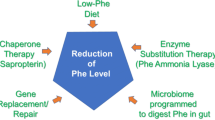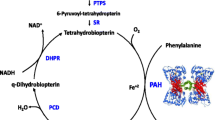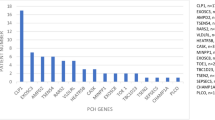Abstract
Phenylketonuria (PKU) is an autosomal recessive disorder characterized by a mutation in the phenylalanine hydroxylase (PAH) gene. Untreated PKU can lead to mental retardation, seizures, and other serious medical problems. This study was designed to investigate the status of molecular defects in the PAH gene and their association with polymorphisms in Kurdish patients with PKU in the Kermanshah province, western Iran. The study was conducted on 27 unrelated patients with PKU over a 2-year period (from 2010 to 2012). All 13 exons plus exon-intron boundaries of the PAH gene were analyzed and we identified 15 different mutations, including two novel mutations, in 51 of the 54 mutant alleles (diagnostic efficiency of 94.4 %). IVS4 + 1G > C (c.441 + 1G > C) and IVS7 − 5 T > C (c.843 − 5 T > C) are novel mutations that have not been reported in the academic literature or the PAH locus database (http://www.pahdb.mcgill.ca); therefore, they may be specific to the Kurdish population. IVS2 + 5G > C and IVS9 + 5G > A were the two most prevalent mutations in our sample, with frequencies of 26 % and 17 %, respectively. The second most common mutations were p.R261X, IVS10 − 11G > A, p.K363 > Nfs and IVS7 − 5 T > C, with each showing a relative frequency of 7.4 %. All other detected mutations, including p.F55 > Lfs, p.R176X, p.R243Q, p.V230I, p.R243X, p.R261Q, IVS8 − 7A > G and p.E390G had frequencies of less than 4 %. The present study showed that there is a distinct difference in the characteristics of PAH mutations between the Kermanshah province and other parts of Iran, suggesting that Kermanshah may have a unique population distribution of PAH gene mutations. Iran lies on the route of major ancient movements of the Caucasian people toward the Mediterranean basin, and Kermanshah has previously been called the gateway to Asia. Most of the mutations identified in this study are common in the Mediterranean region. Therefore, our findings are consistent with the historical and geographical links between the Iranian population and the populations of Mediterranean region.

Similar content being viewed by others
References
Bickel H, Bachmann C, Beckers R, Brandt NJ, Clayton BE, Corrado G, Feingold HJ, Giardini O, Hammersen G, Schonberg D (1981) Neonatal mass screening for metabolic disorders. Eur J Pediatr 137:133–139
Bonyadi M, Omrani O, Moghanjoghi SM, Shiva S (2010) Mutations of the phenylalanine hydroxylase gene in Iranian Azeri Turkish patients with phenylketonuria. Genet Test Mol Biomarkers 14(2):233–235
Georgiou T, Ho G, Vogazianos M, Dionysiou M, Nicolaou A, Chappa G, Nicolaides P, Stylianidou G, Christodoulou J, Drousiotou A (2012) The spectrum of mutations identified in Cypriot patients with phenylalanine hydroxylase deficiency detected through neonatal screening. Clin Biochem 45(7–8):588–592
Hamzehloei T, Hosseini SA, Vakili R, Mojarad M (2012) Mutation spectrum of the PAH gene in the PKU patients from Khorasan Razavi province of Iran. Gene 506(1):230–232
Hashem N, Bosco P, Chiavetta V, Cali F, Ceratto N, Romano V (1996) Preliminary studies on the molecular basis of hyperphenylalaninemia in Egypt. Hum Genet 98(1):3–6
Hufton SE, Jennings IJ, Cotton RG (1995) Structure and function of the aromatic amino acid hydroxylases. Biochem J 311:353–366
Kayaalp E, Treacy E, Waters PJ, Byck S, Nowacki P, Scriver CR (1997) Human phenylalanine hydroxylase mutations and hyperphenylalaninemia phenotypes: a metanalysis of genotype-phenotype correlations. Am J Hum Genet 61:1309–1317
Moradi K, Alibakhshi R, Ghadiri K, Khatami SR, Galehdari H (2012) Molecular analysis of exons 6 and 7 of phenylalanine hydroxylase gene mutations in Phenylketonuria patients in Western Iran. J Hum Genet 12(3):284–287
Mount SM (1982) A catalogue of splice junction sequences. Nucleic Acids Res 10(2):459–472
Santana da Silva LC, Carvalho TS, da Silva FB, Morari L, Fachel AA, Pires R, Refosco LF, Desnick RJ, Giugliani R, Saraiva Pereira ML (2003) Molecular characterization of phenylketonuria in South Brazil. Mol Genet Metab 79(1):17–24
Santos LL, Fonseca CG, Starling AL, Januario JN, Aguiar MJ, Peixoto MG, Carvalho MR (2010) Variations in genotype-phenotype correlations in phenylketonuria patients. Genet Mol Res 9(1):1–8
Scriver CR, Hurtubise M, Konecki D, Phommarinh M, Prevost L, Erlandsen H, Stevens R, Waters PJ, Ryan S, McDonald D, Sarkissian C (2003) PAHdb: what a locus-specific knowledgebase can do? Hum Mutat 21:333–344
Scriver CR, Prevost L, Hurtubise M, Konecki D, Dobrowolski SF(curators). PAHdb Phenylalanine Hydroxylase Locus Knowledgebase, URL: http://www.pahdb.mcgill.ca, update, 2009.08.31
Soltani MA (1999) Historical geography and comprehensive history of Kermanshah. Soha Press, Tehran
Surtees R, Blau N (2000) The neurochemistry of phenylketonuria. Eur J Pediatr 159(2):109–113
Vallian S, Barahimi E, Moeini H (2003) Phenylketonuria in Iranian population: a study in institutions for mentally retarded in Isfahan. Mutat Res 526:45–52
Williams RA, Mamotte CDS, Burnett JR (2008) Phenylketonuria: an inborn error of phenylalanine metabolism. Clin Biochem Rev 29(1):31–41
Yilmaz E, Cali F, Roman V, Ozalp I, Co§kun T, Tokatli A, Kalkanoglu HS, Ozgug M (2000) Molecular basis of mild hyperphenylalaninaemia in Turkey. J Inherit Metab Dis 23:523–525
Zare-Karizi SH, Hosseini-Mazinani SM, Khazaei-Koohpar Z, Seifati SM, Shahsavan-Behboodi B, Akbari MT, Koochmeshgi J (2011) Mutation spectrum of phenylketonuria in Iranian population. Mol Genet Metab 102(1):29–32
Zschocke J (2003) Phenylketonuria mutations in Europe. Hum Mutat 21:345–356
Zschocke J, Hoffmann GF (1999) Phenylketonuria mutations in Germany. Hum Genet 104:3908
Zygulska M, Eigel A, Pietrzyk JJ, Horst J (1993) Phenylalanine hydroxylase gene: a novel splice mutation in intron 2 in two German and Polish families with severe phenylketonuria. Hum Mutat 2(3):238–239
Acknowledgments
The authors are thankful to the patients and their families for consenting to participate in this study. We would also like to especially thank all the people in the Medical Genetics Laboratory at Kermanshah University of Medical Sciences for their great collaboration and kindness. The Vice Chancellor for Research at Kermanshah University of Medical Sciences in Iran has provided a grant to support this study.
Author information
Authors and Affiliations
Corresponding author
Rights and permissions
About this article
Cite this article
Alibakhshi, R., Moradi, K., Mohebbi, Z. et al. Mutation analysis of PAH gene in patients with PKU in western Iran and its association with polymorphisms: identification of four novel mutations. Metab Brain Dis 29, 131–138 (2014). https://doi.org/10.1007/s11011-013-9432-0
Received:
Accepted:
Published:
Issue Date:
DOI: https://doi.org/10.1007/s11011-013-9432-0




